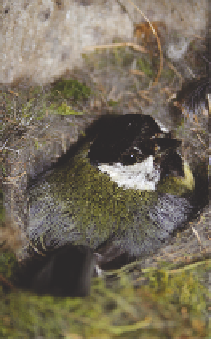Biology Reference
In-Depth Information
(a)
(ii)
(i)
(iii)
(b)
140
1
0.9
120
0.8
100
0.7
0.6
80
0.5
60
0.4
0.3
40
0.2
20
0.1
0
0
1
2345
6
7
8
9
10
11
12
13
14
Clutch size
Fig. 1.5
(a) (i) Wytham Woods, Oxford, the site of a long-term study of great tit reproductive behaviour.
Photo © Jane Carpenter (ii) A nest box. Photo © Ben Sheldon. (iii) Female great tit incubating a clutch. Photo
© Sandra Bouwhuis (b) Bars: The frequency distribution of the clutch size of great tits in Wytham Woods. Most
pairs lay 8-9 eggs. Curve and blue dots: Experimental manipulation of brood size shows that the clutch size
that maximizes the number of surviving young per brood is slightly larger than the average observed clutch size.
From Perrins (1965).
metabolic rates of animals, only two examples were found of animals working at more
than seven times their resting metabolic rate: breeding birds and cyclists on the Tour de
France cycle race (Peterson
et al
., 1990).
The significance of nestling weight is that heavier chicks survive better (Fig. 1.6b).
Therefore, an over-ambitious parent will leave fewer surviving young because it cannot
feed its nestlings adequately. By creating broods of different sizes experimentally and
allocating them at random to different nests, it was demonstrated that there is an
… is less than that
predicted to
maximize the
number of
surviving young
per brood


















































































